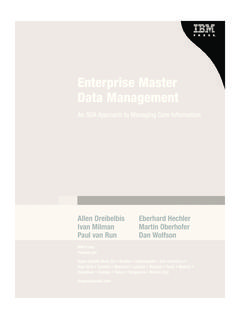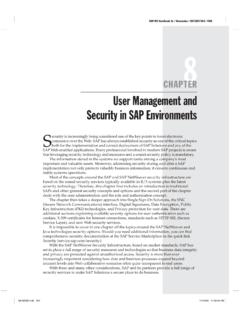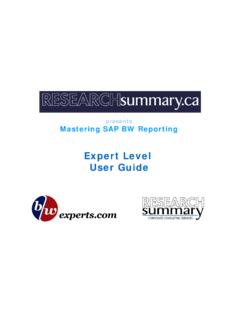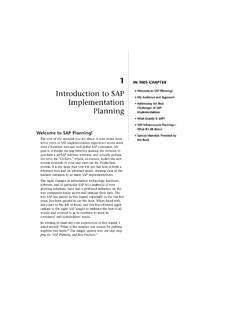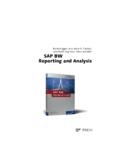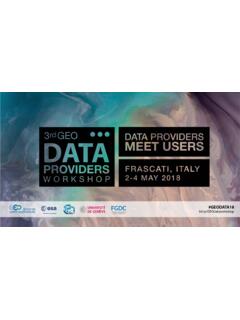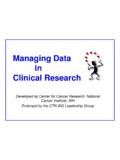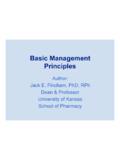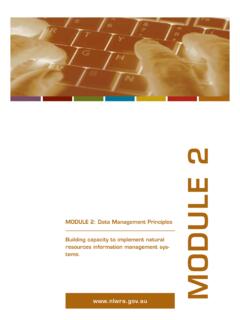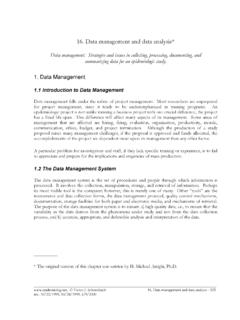Transcription of pArt Architectural - cdn.ttgtmedia.com
1 CompRef8 / Master data management and data governance / Berson / 458-4 IIArchitectural ConsiderationsChApter 4 MDM Architecture Classification, Concepts, principles , and ComponentsChApter 5 data management Concerns of MDM Architecture: Entities, Hierarchies and MetadataChApter 6 MDM Services for Entity and Relationships Resolution and Hierarchy ManagementChApter 7 Master data 7710/15/10 4:11:50 PMCompRef8 / Master data management and data governance / Berson / 458-4 78 part II: Architectural ConsiderationsIn the introductory part of this book, we offered a broad-brush description of the purpose, drivers, and key benefits of Master data management and used some specific examples of its customer-focused variant, Customer data Integration.
2 This part of the book discusses the issues of MDM architecture as a key logical step to building enterprise-wide architecture discussion is important for several reasons:A comprehensive end-to-end MDM solution is much more than just a database of customer or product information organized by some kind of a unique key. Some MDM capabilities and components are traditional and are a part of a common best-practice design for integrated data solutions, whereas other, new features came to light primarily in the context of MDM problem domains. An Architectural vision can help organize the old and the new features into an integrated, scalable, and manageable is not just a technology problem a comprehensive MDM solution consists of technology components and services as well as new business processes and even organizational structures and dynamics.
3 There are many architecture viewpoints, significant complexity, and a large number of interdependencies to warrant a framework-based approach to the architecture. This multifaceted, multidimensional architecture framework looks at the overall problem domain from different but complementary solution intended to create an authoritative, accurate, and timely system of record that should eventually replace existing legacy sources of the information must be integrated with the overall enterprise architecture and infrastructure. Given the heterogeneity and the age of legacy systems, this requirement is often difficult to satisfy without a comprehensive architecture , we organized this part of the book in the following fashion: First, we discuss the Architectural genesis of MDM.
4 Then, we take a closer look at the enterprise architecture framework and explain how this framework helps us to see different aspects of the solution as interconnected and interdependent views. This discussion is followed by an overview of traditional data management and emerging concerns of MDM architecture, MDM data modeling, data management architecture, and the newer concept of MDM 7810/15/10 4:11:50 PM 78 part II: Architectural ConsiderationsCompRef8 / Master data management and data governance / Berson / 458-44 MDM Architecture Classifications, Concepts, principles , and ComponentsIn order to understand how to build a comprehensive Master data management solution, we need to define the what of Master data have already offered high-level definitions of MDM and its customer-focused variant, CDI, in Part I of this book.
5 We also stated that CDI and other MDM variants share many architecture principles and approaches; therefore, in this part of the book we concentrate on common architecture aspects of Master data management . Where appropriate, we ll mention specific architecture features of key MDM variants in particular, Customer data Integration and Product Information Definition of Master data ManagementAs shown in previous chapters, the scope of Master data management by its very nature is extremely broad and applies equally well to customer-centric, product-centric, and reference data centric business problems, to name just a few. A common thread among the solutions to these problems is the ability to create and maintain an accurate, timely, and authoritative system of record for a given subject domain.
6 Clearly, such a definition can be refined further for each situation and problem domain addressed by Master data s start with a fresh look at the definitions of master data and Master data management offered in Chapter 1:Master data is composed of those entities, relationships, and attributes that are critical for an enterprise and foundational to key business processes and application data management (MDM) is the framework of processes and technologies aimed at creating and maintaining an authoritative, reliable, sustainable, accurate, and secure data environment that represents a single and holistic version of the truth, for master data and its relationships, as well as an accepted benchmark used 7910/15/10 4:11:50 PMCompRef8 / Master data management and data governance / Berson / 458-4 80 part II: Architectural Considerations Chapter 4.
7 MDM Architecture Classifications, Concepts, principles , and Components 81within an enterprise as well as across enterprises and spanning a diverse set of application systems, lines of business, channels, and user communities. To state it slightly differently, an MDM solution takes the master data of a given domain from a variety of data sources discards redundant data ; and then cleanses, rationalizes, enriches, and aggregates it to the extent possible. We can illustrate such an MDM environment as a hub and spokes, where the spokes are information sources connected to the central hub as a new home for the accurate, aggregated, and timely master data (see Figure 4-1). This description helps explain why we often use the term data Hub when discussing an MDM solution , using this definition of what MDM is does not make our goal of creating architecture much easier to achieve.
8 Indeed, this definition points to the fact that, for example, a CDI solution is much more than just a database of customer information, a solution known by many as a Customer Information File (CIF), a data warehouse of customer information, or an operational data store (ODS). In fact, this definition describes an enterprise-scale system that consists of software components, services, processes, data models and data stores, metadata repositories, applications, networks, and other infrastructure , in order to develop a clear understanding of the how of the MDM solution, we will review the historical roots of Master data management and its evolution from early attempts to deliver on the MDM promise to what it has become HubProductMasterCreditDatabaseMarketingD atamartSalesDatamartFi g u r e 4-1 MDM Customer/Product data 8010/15/10 4:11:51 PM 80 part II: Architectural ConsiderationsCompRef8 / Master data management and data governance / Berson / 458-4pArt II Chapter 4.
9 MDM Architecture Classifications, Concepts, principles , and Components 81 Evolution of Master data management ArchitectureAs we discussed in Chapter 1, the need to create and maintain an accurate and timely information system of record is not new, and it applies equally well to businesses and government entities. Lately, a number of regulatory requirements, including the Sarbanes-Oxley Act, the Basel II Capital Accord, and the emerging Basel III Accord (see the discussion on these regulations in Part III of the book), have emphasized this need even the case of Customer data Integration, organizations have been engaged in creating customer-centric business models and applications and enabling infrastructure for a long time.
10 However, as the business complexity, number and type of customers (retail customers, individuals, institutional customers, and so on), number of lines of business, and number of sales and service channels continued to grow, this growth often proceeded in a tactical, nonintegrated fashion. As result, many organizations ended up with a wide variety of customer information stores and applications that manage customer data . As an example, one medium-sized service/distribution company maintained no less than eight customer databases that had to be rationalized and cleansed in order to achieve targeted goals for efficiency and quality of the customer customer data in that legacy environment was often incomplete and inconsistent across various data stores, applications, and lines of business.
